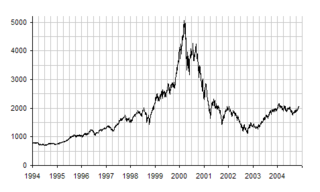Comparison with other financial instruments
This section possibly contains original research .(October 2016) |
There are a number of different financial instruments that have been used in the past to speculate on financial markets. These range from trading in physical shares either directly or via margin lending, to using derivatives such as futures, options or covered warrants. A number of brokers have been actively promoting CFDs as alternatives to all of these products. [36]
The CFD market most resembles the futures and options market, the major differences being: [37] [38]
- There is no expiry date, so no time decay;
- Trading is done over-the-counter with CFD brokers or market makers;
- CFD contract is normally one to one with the underlying instrument;
- CFD trading is banned in Belgium (for OTC instruments only), [39] the United States and Hong Kong;
- Minimum contract sizes are small, so it's possible to buy one share CFD;
- Easy to create new instruments: not restricted to exchange definitions or jurisdictional boundaries, so very wide selection of underlying instruments can be traded.
Futures
CFDs and Futures trading are both forms of derivatives trading. A futures contract is an agreement to buy or sell the underlying asset at a set price at a set date in the future, regardless of how the price changes in the meanwhile. [36] Professionals prefer future contracts for indices and interest rate trading over CFDs as they are a mature product and are exchange traded. The main advantages of CFDs, compared to futures, is that contract sizes are smaller making it more accessible for small traders and pricing is more transparent. Futures contracts tend to only converge to the price of the underlying instrument near the expiry date, while the CFD never expires and simply mirrors the underlying instrument. [40] [41]
Futures are often used by the CFD providers to hedge their own positions and many CFDs are written over futures as futures prices are easily obtainable. CFDs don't have expiry dates so when a CFD is written over a futures contract the CFD contract has to deal with the futures contract expiration date. The industry practice is for the CFD provider to 'roll' the CFD position to the next future period when the liquidity starts to dry in the last few days before expiry, thus creating a rolling CFD contract. [40]
Options
Options, like futures, are established products that are exchange traded, centrally cleared and used by professionals. Options, like futures, can be used to hedge risk or to take on risk to speculate. CFDs are only comparable in the latter case.[ contradictory ] The main advantage of CFDs over options is the price simplicity and range of underlying instruments. An important disadvantage is that a CFD cannot be allowed to lapse, unlike an option. This means that the downside risk of a CFD is unlimited, whereas the most that can be lost on an option (by a buyer) is the price of the option itself. In addition, no margin calls are made on options if the market moves against the trader.[ citation needed ]
Compared to CFDs, option pricing is complex and has price decay when nearing expiry while CFDs prices simply mirror the underlying instrument. CFDs cannot be used to reduce risk in the way that options can.[ contradictory ]
Covered warrants
Similar to options, covered warrants have become popular in recent years as a way of speculating cheaply on market movements. CFDs costs tend to be lower for short periods and have a much wider range of underlying products. In markets such as Singapore, some brokers have been heavily promoting CFDs as alternatives to covered warrants, and may have been partially responsible for the decline in volume of covered warrant. [42]
Physical shares, commodities and foreign exchange
This is the traditional way to trade financial markets, this requires a relationship with a broker in each country, require paying broker fees and commissions and dealing with settlement process for that product. With the advent of discount brokers, this has become easier and cheaper, but can still be challenging for retail traders particularly if trading in overseas markets. Without leverage this is capital intensive as all positions have to be fully funded. CFDs make it much easier to access global markets for much lower costs and much easier to move in and out of a position quickly. All forms of margin trading involve financing costs, in effect the cost of borrowing the money for the whole position.[ citation needed ]
Margin lending
Margin lending, also known as margin buying or leveraged equities, have all the same attributes as physical shares discussed earlier, but with the addition of leverage, which means like CFDs, futures, and options much less capital is required, but risks are increased. Since the advent of CFDs, many traders have moved from margin lending to CFD trading. The main benefits of CFD versus margin lending are that there are more underlying products, the margin rates are lower, and it is easy to go short. Even with the recent bans on short selling, CFD providers who have been able to hedge their book in other ways have allowed clients to continue to short sell those stocks.[ citation needed ]

